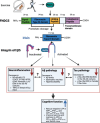Therapeutic potential of exercise-hormone irisin in Alzheimer's disease
- PMID: 38993140
- PMCID: PMC11688551
- DOI: 10.4103/NRR.NRR-D-24-00098
Therapeutic potential of exercise-hormone irisin in Alzheimer's disease
Abstract
Irisin is a myokine that is generated by cleavage of the membrane protein fibronectin type III domain-containing protein 5 (FNDC5) in response to physical exercise. Studies reveal that irisin/FNDC5 has neuroprotective functions against Alzheimer's disease, the most common form of dementia in the elderly, by improving cognitive function and reducing amyloid-β and tau pathologies as well as neuroinflammation in cell culture or animal models of Alzheimer's disease. Although current and ongoing studies on irisin/FNDC5 show promising results, further mechanistic studies are required to clarify its potential as a meaningful therapeutic target for alleviating Alzheimer's disease. We recently found that irisin treatment reduces amyloid-β pathology by increasing the activity/levels of amyloid-β-degrading enzyme neprilysin secreted from astrocytes. Herein, we present an overview of irisin/FNDC5's protective roles and mechanisms against Alzheimer's disease.
Copyright © 2025 Copyright: © 2025 Neural Regeneration Research.
Conflict of interest statement
Figures

References
-
- Belarbi K, et al. Beneficial effects of exercise in a transgenic mouse model of Alzheimer’s disease-like Tau pathology. Neurobiol Dis. 2011;43:486–494. - PubMed
-
- Bostrom P, Wu J, Jedrychowski MP, Korde A, Ye L, Lo JC, Rasbach KA, Bostrom EA, Choi JH, Long JZ, Kajimura S, Zingaretti MC, Vind BF, Tu H, Cinti S, Hojlund K, Gygi SP, Spiegelman BM. A PGC1-alpha-dependent myokine that drives brown-fat-like development of white fat and thermogenesis. Nature. 2012;481:463–468. - PMC - PubMed
Grants and funding
LinkOut - more resources
Full Text Sources

